解説:池田光穂
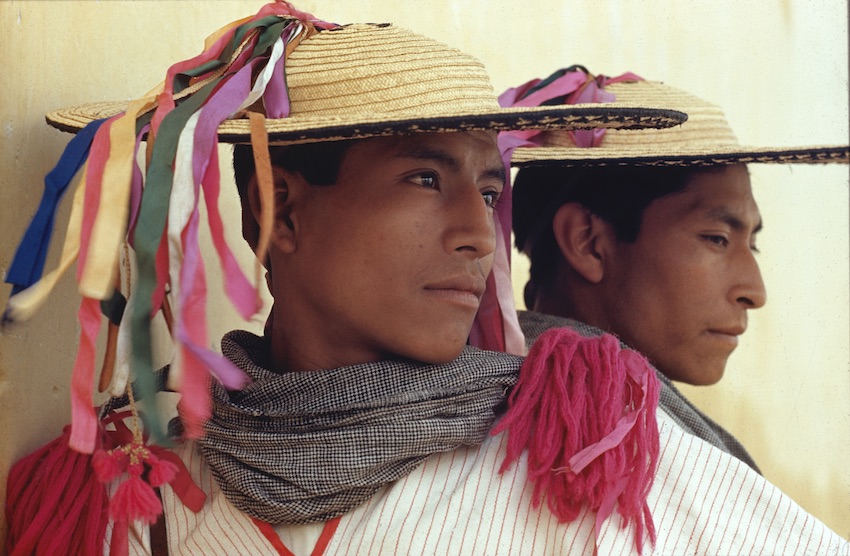
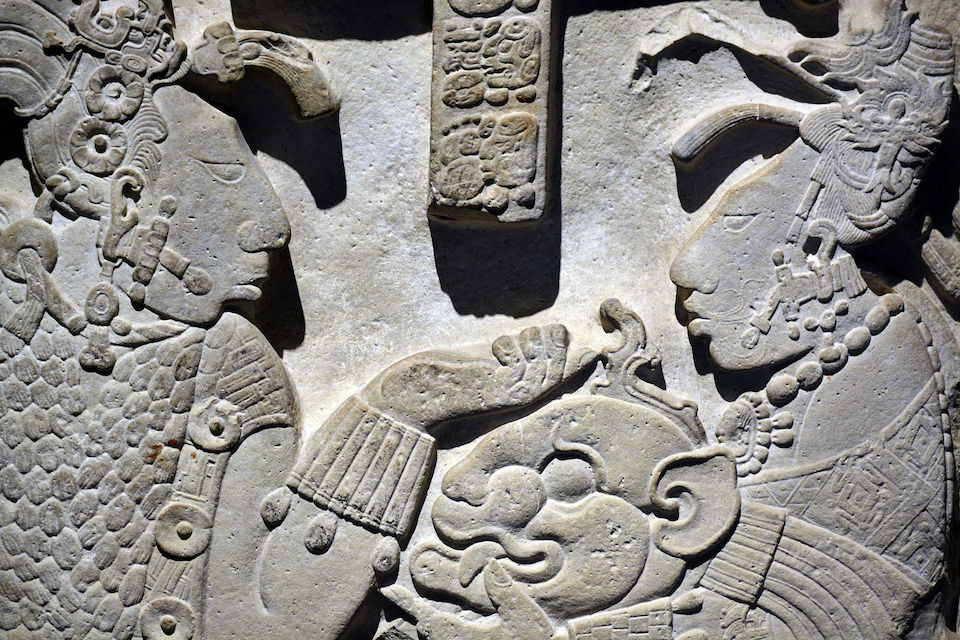
左::メキシコ・チアパス州のシナカンタンの若者(George E. Stuart and National
Geographic);右:ヤ
シュチラン遺跡の石彫(Detail of Lintel 26 from Yaxchilan)
マヤ民族(マヤ人)︎▶︎マヤ遺跡
観光▶︎︎マヤ文化と社会▶︎マヤ先住民表象のダイナミズム(Ver.2.0)2009▶︎︎ポータル:マヤ学入門▶Todos Santeros y Yo︎▶︎︎現代のマヤの人口を推定する▶︎マヤ遺跡観光▶︎︎▶︎▶︎
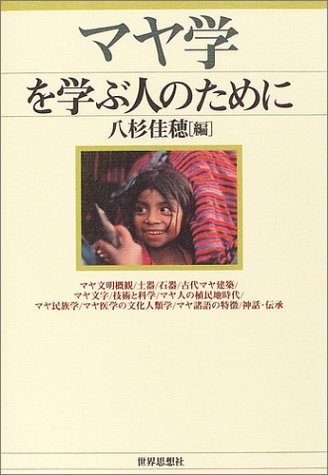
「みなさんはマヤ文明について見たり聞いたりしたこ
とがあるでしょう? 映画『スターウォーズ』
(1977)の反乱軍の基地として有名になった熱帯雨林にそびえ立つティカル遺跡のピラミッド、精緻なカレンダーシステム、解明がすすんだマヤ文字な
ど。マヤ文明はエキゾチックな魅力でいっぱいです。しかし他方でグアテマラ高地の先住民族であるマ
ヤ人は、36年にわたる内戦のみならず現在においても虐
殺や政治的抑圧の対象でもあります。この授業では、マヤ民族のうちマム語を話す人びとたちに焦点をあてて、その文化と社会について考えてみたいと思いま
す」(「グアテマラのマヤ文化と社会」より)。
現
代のマヤの人口を推定する;【主張】現在のマヤ民族は、メキシコ南部(チアパス州、ラカンドン低地、ユカタン半島)、ベリーズ、グアテマラ、ホン
ジュラス(西部)ならびにアメリカ合衆国の各地に居住しており、およそ800万から1000万の総人口をもつと推計される。【根拠】世界のマヤ人の総人口
(2004年)を800万から1000万とした推定の根拠は次のとおりである。グアテマラ国内人口の推計(アメリカ合衆国政府公表)1150万人と国外の
労働者推計人口117万人(日刊紙『プレンサ・リブレ紙』2003年9月14日付)の合算の「6割」(根拠は Leopoldo
1997:50)、つまり760万人に、メキシコ国内のマヤ人口94万人――国立先住民研究所による1995年推計統計(INI,
Online)ではマヤという統一カテゴリとそれぞれの各言語別人口が混在しており、それらを合算すると210万人になるがその正確な包摂関係が記されて
いない――を合算したものが854万人(INI統計を単純集計と考えると970万人)である。ただし、このカウントにはメキシコ出身の海外在住のマヤ人が
含まれていない。言うまでもなく、マヤ人の人口統計は当事者の民族的帰属意識によるカウ
ントがもっとも「公正」である。しかし、これまでの歴史的統計は「先住民性」を操作的に規定する研究者の推計に他ならないし、国家統計調査では、非マヤの
調査官による判別や“先住民の文化的特質は将来消失しより大きな国民的範疇に包合されるだろう”という反先住民的偏見や先住民への差別意識により、統計上
の人口規模は過小評価され年次を重ねて減少傾向にあるという「事実」が積み重ねられてきた(Leopoldo
1997)。したがって公表される先住民人口統計にはつねに注意が必要である。Leopoldo, Tzian 1997 Kajlab'aliil
Maya'iib' Xuq Mu'siib': Ri Ub'antajiik Iximuleew ( Mayas y Ladinos en
Cifras: El caso de Guatemala). Guatemala: Cholsamaj.
The Maya
civilization developed within the Maya Region, a Mesoamerican cultural
area, which covers a region that spreads from northern Mexico
southwards into Central America.[3] Mesoamerica was one of six cradles
of civilization worldwide.[4] The Mesoamerican area gave rise to a
series of cultural developments that included complex societies,
agriculture, cities, monumental architecture, writing, and calendrical
systems.[5] The set of traits shared by Mesoamerican cultures also
included astronomical knowledge, blood and human sacrifice, and a
cosmovision that viewed the world as divided into four divisions
aligned with the cardinal directions, each with different attributes,
and a three-way division of the world into the celestial realm, the
earth, and the underworld.[6]
|
マヤ文明は、メキシコ北部から中米にかけてのメソアメリカ文化圏である
マヤ地方で発展した[3]。メソアメリカは、世界6大文明発祥地のひとつである[4]。
[5]メソアメリカ文化が共有する一連の特徴には、天文学的知識、血と人間の犠牲、そして世界を、それぞれ異なる属性を持つ、枢機卿の方位に沿った4つの
部門に分割して見る宇宙観、天界、地上、地下への世界の3方向分割も含まれていました[6]。
|
By 6000 BC, the early
inhabitants of Mesoamerica were experimenting with the domestication of
plants, a process that eventually led to the establishment of sedentary
agricultural societies.[7] The diverse climate allowed for wide
variation in available crops, but all regions of Mesoamerica cultivated
the base crops of maize, beans, and squashes.[8] All Mesoamerican
cultures used Stone Age technology; after c. 1000 AD copper, silver and
gold were worked. Mesoamerica lacked draft animals, did not use the
wheel, and possessed few domesticated animals; the principal means of
transport was on foot or by canoe.[9] Mesoamericans viewed the world as
hostile and governed by unpredictable deities. The ritual Mesoamerican
ballgame was widely played.[10] Mesoamerica is linguistically diverse,
with most languages falling within a small number of language
families—the major families are Mayan, Mixe–Zoquean, Otomanguean, and
Uto-Aztecan; there are also a number of smaller families and isolates.
The Mesoamerican language area shares a number of important features,
including widespread loanwords, and use of a vigesimal number
system.[11]
|
紀元前6000年頃には、メソアメリカの初期住民は植物の家畜化を試み
ており、このプロセスは最終的に定住型農業社会の確立につながった[7]。多様な気候により、収穫できる作物は大きく異なるが、メソアメリカのすべての地
域でトウモロコシ、豆、カボチャという基礎作物が栽培されていた[8]。メソアメリカは徴用動物を持たず、車輪も使わず、家畜化された動物もほとんど持っ
ていませんでした。メソアメリカは言語的に多様で、ほとんどの言語は少数の言語族(マヤ語族、ミックス・ゾクアン語族、オトマンゲ語族、ウト・アステカ語
族)に属しています。メソアメリカ言語圏は、広範な借用語や金数法の使用など、多くの重要な特徴を共有している[11]。
|
The territory of the Maya
covered a third of Mesoamerica,[12] and the Maya were engaged in a
dynamic relationship with neighbouring cultures that included the
Olmecs, Mixtecs, Teotihuacan, the Aztecs, and others.[13] During the
Early Classic period, the Maya cities of Tikal and Kaminaljuyu were key
Maya foci in a network that extended beyond the Maya area into the
highlands of central Mexico.[14] At around the same time, there was a
strong Maya presence at the Tetitla compound of Teotihuacan.[15]
Centuries later, during the 9th century AD, murals at Cacaxtla, another
site in the central Mexican highlands, were painted in a Maya
style.[16] This may have been either an effort to align itself with the
still-powerful Maya area after the collapse of Teotihuacan and ensuing
political fragmentation in the Mexican Highlands,[17] or an attempt to
express a distant Maya origin of the inhabitants.[18] The Maya city of
Chichen Itza and the distant Toltec capital of Tula had an especially
close relationship.[19]
|
マヤの領土はメソアメリカの3分の1を占めており[12]、マヤはオル
メカ、ミクステカ、テオティワカン、アステカなどを含む近隣の文化とダイナミックな関係を築いていた。 [13]
古典前期、マヤの都市ティカルとカミナルジュユは、マヤの領域を超えて中央メキシコの高地にまで広がるネットワークにおけるマヤの重要な拠点でした
[14]。ほぼ同時期に、テオティワカンのテティトラ遺跡にマヤが強く存在していました。 [15]
それから数世紀後の西暦9世紀には、メキシコ中央部の高地にある別の遺跡、カカストラの壁画がマヤの様式で描かれていた。
[16]これは、テオティワカンの崩壊とそれに伴うメキシコ高地の政治的分断の後、依然として強力なマヤ地域と連携するための努力か[17]、あるいは住
民の遠いマヤ起源を表現する試みだったのかもしれない。 18]
マヤ都市チチェン・イッツァと遠いトルテック族の首都トゥーラは特に密接な関係を持っていた[19]。 |
https://en.wikipedia.org/wiki/Maya_civilization
|
|
2002年4月30日の授業で解説しまし
たが、このビデオの論理的構成は次のようになっています。思い出しながら、整理して下さい。ま
た、皆さんの関心がどこにあるのか、自分で分析しましょう。
●THE GUATEMALAN MAYA CENTRE
-- 94B Wandsworth Bridge Road, London SW6 2TF : : : : :
curator@maya.org.uk

This outstanding work documents
traditional religious specialists and their practices among Chuj,
Q’anjob’al, and Akatek Mayan speakers residing in the remote fastness
of the high Cuchumatan mountains in northwest Guatemala’s department of
Huehuetenango. Detailed and specific, the book is long on data and
thankfully less concerned with analysis. It is invaluable as a record
of disappearing traditions and equally valuable as information
contributing to understanding the meanings of related traditions placed
in context and explained by followers of those traditions.
グアテマラ北西部ウエウエテナンゴ県にあるクチュマタン山脈の高地に住むチュフ、カンホ
バル、アカテック・マヤの伝統的な宗教専門家とその実践を記録した優れた著作。本書は、詳細かつ具体的で、データに長いが、ありがたいことに分析には
あまり関心がない。本書は、失われつつある伝統の記録として貴重であると同時に、関連する伝統の意味を理解するのに役立つ情報として、その伝統の信奉者が
文脈に即して説明したものであり、同様に価値がある。
Archaeologists and epigraphers will find
careful descriptions of material goods and fascinating practices that
may help identify excavated materials and activities from earlier
times. Ethnohistorians will be pleased to find that Krystyna Deuss
discusses relevant materials provided by earlier ethnographers and has
numerous comments on ritual practices, when some of them originated if
known, and when some practices were no longer present. Art historians
will encounter images and their descriptions that beg comparison with
images from Classic period iconography, as, for example, with the
sacred bundle associated with change of office rituals, or the
placement of altars and crosses as approaches to the supernatural
world, or the staff of office carried by community authorities.
Anthropological linguists too are provided ample material for
identification and analysis, such as an appendix of prayers and
invocations in the original Mayan languages as well as in English
translation, and Deuss supplies much of the necessary context for more
fully apprehending their meaning in the book’s main body. Social
anthropologists will of course also find the data fascinating, given
the book’s painstaking and well-illustrated descriptions of feasts and
festivals, life crisis rituals (including birth, baptism, marriage, and
the Day of the Dead), and rituals for planting, rain, preventing frost
damage, and maintaining and renewing the health of the community.
Descriptions are also given for ritual cleaning of the sacred bundles
and for closing-the-year ceremonies that entail cutting new staffs of
office, cleaning the prayer-sayer’s house, and closing the altars.
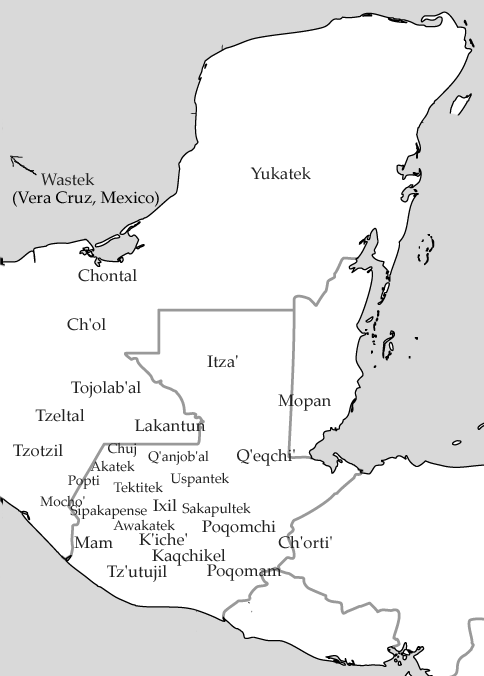 考古学者やエピグラファーは、発掘された資料や以前
の活動を特定するのに役立つかもしれない、物質的な品物や魅力的な慣習に関する丁寧な記述を見つけるこ
とができるでしょう。民族史家は、Krystyna
Deussが以前の民族学者によって提供された関連資料を考察し、儀式慣行について、その起源がわかっている場合はその時期、いくつかの慣行がもはや存在
しない場合について多くのコメントを残していることに満足することでしょう。美術史家は、古典期の図像と比較する必要がある画像とその記述に出会う。例え
ば、交代儀式に関連する神聖な束、超自然的な世界へのアプローチとしての祭壇と十字架の配置、コミュニティの権威者が持つ役職の杖などである。人類学的言
語学者にとっても、マヤの原語と英訳による祈りと呼びかけの付録など、識別と分析のための十分な資料が提供され、ドイスは本書の本文でその意味をより深く
理解するために必要な多くの文脈を提供しています。もちろん、社会人類学者にとっても、本書は興味深い資料である。祝祭日や祭事、生命の危機に関する儀式
(誕生、洗礼、結婚、死者の日など)、植樹、雨、凍害防止、コミュニティの健康の維持・更新に関する儀式などが、丹念かつ詳細に図解されているからであ
る。また、神棚の掃除や、新しい杖を切り、祈祷師の家を掃除し、祭壇を閉じるという年末の儀式についても説明されている。
考古学者やエピグラファーは、発掘された資料や以前
の活動を特定するのに役立つかもしれない、物質的な品物や魅力的な慣習に関する丁寧な記述を見つけるこ
とができるでしょう。民族史家は、Krystyna
Deussが以前の民族学者によって提供された関連資料を考察し、儀式慣行について、その起源がわかっている場合はその時期、いくつかの慣行がもはや存在
しない場合について多くのコメントを残していることに満足することでしょう。美術史家は、古典期の図像と比較する必要がある画像とその記述に出会う。例え
ば、交代儀式に関連する神聖な束、超自然的な世界へのアプローチとしての祭壇と十字架の配置、コミュニティの権威者が持つ役職の杖などである。人類学的言
語学者にとっても、マヤの原語と英訳による祈りと呼びかけの付録など、識別と分析のための十分な資料が提供され、ドイスは本書の本文でその意味をより深く
理解するために必要な多くの文脈を提供しています。もちろん、社会人類学者にとっても、本書は興味深い資料である。祝祭日や祭事、生命の危機に関する儀式
(誕生、洗礼、結婚、死者の日など)、植樹、雨、凍害防止、コミュニティの健康の維持・更新に関する儀式などが、丹念かつ詳細に図解されているからであ
る。また、神棚の掃除や、新しい杖を切り、祈祷師の家を掃除し、祭壇を閉じるという年末の儀式についても説明されている。
Based on fieldwork spanning some thirty
years, beginning in 1974, this book is written in the first person, in
a straightforward narrative style, making it both interesting and easy
for the reader to understand. One of its standout points is that it is
exceptionally well illustrated, with fifty drawings (including four
maps) and a hundred photographs, all of them relevant and well chosen.
The drawings are particularly useful for grasping the details of
placement and the positioning of individuals during ritual activities
as well as of the ceremonial paraphernalia used. The communities
selected for description are Santa Eulalia, Chimbán, Soloma, San Juan
Ixcoy, San Sebastián Coatán, and San Mateo Ixtatán.
本書は、1974年から約30年にわたるフィールドワークに基づき、一人称で、わかりや
すい語り口で書かれており、読者にとって興味深く、かつ理解しやすいものとなっている。本書の特筆すべき点は、50枚の図面(うち4枚は地図)と100枚
の写真で構成されている点である。特に図版は、儀式中の配置や個人の位置関係、儀式に使用される道具の詳細を把握するのに有効である。記述のために選ばれ
たコミュニティは、サンタ・エウラリア、チンバン、ソロマ、サン・フアン・イクスコイ、サン・セバスティアン・コタン、サン・マテオ・イスタタンです。
It is a rare bit of good fortune for
Mesoamericanists that Deuss has provided such a detailed report and of
a topic that was not part of her original intent. That intent had not
been to examine the shamans, daykeepers, prayer-makers, and witches of
the region, but rather it had been to collect village costumes to
examine how they evolved during the twentieth century. However, her
original interest in clothing led her to meetings with traditional
religious functionaries in the several communities that she visited,
and these encounters led in turn to her being allowed to witness
rituals no other outsider had ever seen. This opportunity, combined
with the eye of a keen observer and the inquiring vision of an
excellent ethnographer, has given us an invaluable contribution to the
ethnography of this Mayan region, one that will surely endure for its
exemplary description, its methodological insights, and the fascinating
customs and traditions themselves that are so clearly presented.
このような詳細な報告を、しかも当初の目的とは異なるテーマで行ったことは、メソアメリ
カ研究者にとって稀に見る幸運である。その目的は、この地域のシャーマン、デイキーパー、祈祷師、魔女を調べることではなく、村の衣装を集め、20世紀に
それらがどのように進化したかを調べることだったのです。しかし、もともと衣服に興味があった彼女は、訪問したいくつかの集落で伝統的な宗教関係者と会う
ことになり、その結果、他の部外者が見たことのない儀式に立ち会うことを許された。このような機会に、鋭い観察者の目と優れた民俗学者の探究心が加わり、
このマヤ地域の民俗学に貴重な貢献ができたのである。

Doesn’t
seem possible’: Londoner who wants to house Afghan refugees, from
The Gardian. Tue 15 Feb 2022 10.50 GMT
●リンク(サイト内)
マヤ先住民表象
のダイナミズム(Ver.2.0)2009年︎▶︎マヤ文字▶︎︎▶︎▶︎︎▶︎▶︎︎▶︎▶︎︎▶︎▶︎
マヤ医学とはなにか/マヤ医学とその倫理について考える/マヤ人の健康の過去・現在・未来/武装蜂起とマヤ遺跡(マヤ文明遺跡観光)/グアテマラのマヤ文化と社会/現代のマヤの人口を推定する/健康の歴史的構築:マヤ医学を事例に/マヤ
文明遺跡観光/マヤ人の病気観と動物/マヤ医学の身体観/先住民のアイデンティティについて考える/マヤ=マム データベース/︎▶︎▶︎︎▶︎▶︎︎▶︎▶︎︎▶︎▶︎︎▶︎▶︎
Q'anjob'al
language︎▶48
RESULTADOS DE LA BÚSQUEDA DE: Q'ANJOB'AL (ALMG)▶︎︎Chuj people▶︎Akatek language▶︎︎▶︎▶︎︎▶︎▶︎︎▶︎▶︎



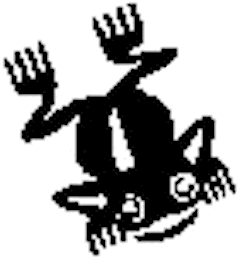

 考古学者やエピグラファーは、発掘された資料や以前
の活動を特定するのに役立つかもしれない、物質的な品物や魅力的な慣習に関する丁寧な記述を見つけるこ
とができるでしょう。民族史家は、Krystyna
Deussが以前の民族学者によって提供された関連資料を考察し、儀式慣行について、その起源がわかっている場合はその時期、いくつかの慣行がもはや存在
しない場合について多くのコメントを残していることに満足することでしょう。美術史家は、古典期の図像と比較する必要がある画像とその記述に出会う。例え
ば、交代儀式に関連する神聖な束、超自然的な世界へのアプローチとしての祭壇と十字架の配置、コミュニティの権威者が持つ役職の杖などである。人類学的言
語学者にとっても、マヤの原語と英訳による祈りと呼びかけの付録など、識別と分析のための十分な資料が提供され、ドイスは本書の本文でその意味をより深く
理解するために必要な多くの文脈を提供しています。もちろん、社会人類学者にとっても、本書は興味深い資料である。祝祭日や祭事、生命の危機に関する儀式
(誕生、洗礼、結婚、死者の日など)、植樹、雨、凍害防止、コミュニティの健康の維持・更新に関する儀式などが、丹念かつ詳細に図解されているからであ
る。また、神棚の掃除や、新しい杖を切り、祈祷師の家を掃除し、祭壇を閉じるという年末の儀式についても説明されている。
考古学者やエピグラファーは、発掘された資料や以前
の活動を特定するのに役立つかもしれない、物質的な品物や魅力的な慣習に関する丁寧な記述を見つけるこ
とができるでしょう。民族史家は、Krystyna
Deussが以前の民族学者によって提供された関連資料を考察し、儀式慣行について、その起源がわかっている場合はその時期、いくつかの慣行がもはや存在
しない場合について多くのコメントを残していることに満足することでしょう。美術史家は、古典期の図像と比較する必要がある画像とその記述に出会う。例え
ば、交代儀式に関連する神聖な束、超自然的な世界へのアプローチとしての祭壇と十字架の配置、コミュニティの権威者が持つ役職の杖などである。人類学的言
語学者にとっても、マヤの原語と英訳による祈りと呼びかけの付録など、識別と分析のための十分な資料が提供され、ドイスは本書の本文でその意味をより深く
理解するために必要な多くの文脈を提供しています。もちろん、社会人類学者にとっても、本書は興味深い資料である。祝祭日や祭事、生命の危機に関する儀式
(誕生、洗礼、結婚、死者の日など)、植樹、雨、凍害防止、コミュニティの健康の維持・更新に関する儀式などが、丹念かつ詳細に図解されているからであ
る。また、神棚の掃除や、新しい杖を切り、祈祷師の家を掃除し、祭壇を閉じるという年末の儀式についても説明されている。
